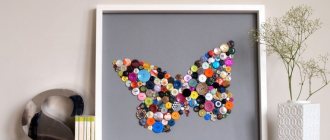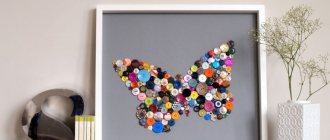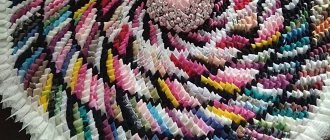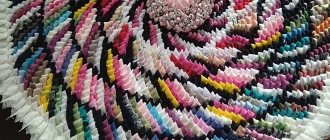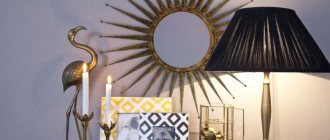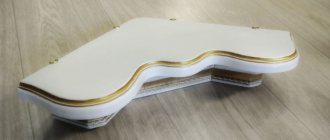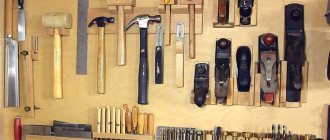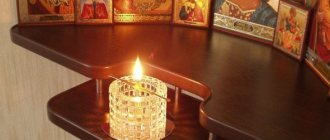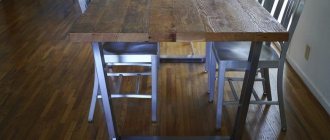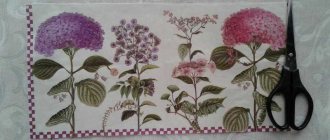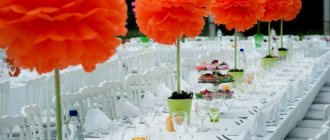A knitted rug is a simple and original way to decorate your apartment. To create a unique product, you should pay attention to the choice of pattern, color and material.
Can you knit? Publish your work on knitka.ru
Choice of material and knitting needles
The choice of yarn for the rug depends on the room where it will be located. Yarn made from the following materials is suitable for different rooms:
- Made from acrylic or cotton. Products made from these materials are well suited for the kitchen. A rug knitted with such threads can be washed several times and not be afraid that it will lose its shape.
- Made from wool. A product knitted from wool is well suited for the bedroom. To give the bedroom an atmosphere of warmth, Angora yarn is suitable.
- Made from synthetic fibers. To add originality to your living room interior, a rug knitted from synthetic yarn is perfect. Products made from such yarn are characterized by high wear resistance.
- Made from plush. A rug knitted from this yarn is perfect for the bathroom. Plush absorbs moisture well.
- Made from jute. This natural material won the hearts of needlewomen. A jute rug knitted with knitting needles can be laid in the hallway in the summer.
Any yarn is suitable for knitting a rug for a child's room. The main thing is that the child likes the product. A rug made from clothesline or cords is perfect for a hallway. This product will be durable. The carpet will also be excellent at removing dirt from the soles of shoes.
Knitting needles should be selected according to the thickness of the yarn. Experienced craftswomen advise using knitting needles approximately twice as thick as the yarn. Knitters also recommend using knitting needles on fishing line to knit a rug. When using such knitting needles, the width of the product can be any.
Design options
Before knitting a rug, knitters take into account the size of the room. You should also pay attention to the shape of the product and the location of the carpet. Craftsmen can knit a rug in the following ways:
- Whole. Knitting the rug starts from the center and continues in the round. To obtain an unusual composition, yarn dyed in different colors is used.
- Sirloin. Before knitting begins, a mesh is formed. After this, yarn of the “grass” type or another variety is used.
- Motives. First, the craftswomen knit circles, triangles or squares separately with knitting needles. The individual elements are then linked together.
The one-piece product is well suited for the toilet or bathroom. A rug knitted with motifs will look great in the living room or bedroom. Experienced craftswomen recommend taking into account the style of the interior when knitting a carpet.
Video: Yarn from a T-shirt. Knitted Improvisation
The yarn is ready, let's start knitting!
Row 1: 2 chain stitches and 11 double crochets.
Round crocheted rug for the floor for beginners: step 1
2nd row: 2 chain loops and 2 double crochets from each loop (according to the diagram).
Round crocheted rug for the floor for beginners: step 2
3rd row: 2 double crochets and 2 double crochets from one loop (according to the diagram).
Round crocheted rug for the floor for beginners: step 3
Row 4 and subsequent ones: according to the pattern, each time adding one double crochet in each section.
Round crocheted rug for the floor for beginners: step 4
We knit the last row to the end and tighten the last loop tightly. As at the beginning of knitting, we hem the edge with thread No. 40 for strength.
Round crocheted rug for the floor for beginners: step 5
Round crocheted rug for the floor for beginners: step 6
Round crocheted rug for the floor for beginners: step 7
Round crocheted rug for the floor for beginners: step 8
Round crocheted floor mat for beginners
Please note that this rug can be knitted with either plain or multi-colored threads.
But it is important that the colors come in sections, and not ripple like our grandmothers. This is the trick that distinguishes fashionable models from grandma's rugs
It is this trick that distinguishes fashionable models from grandma's rugs.
Creation technique
There are several options through which you can obtain such a carpet product. And they will all differ in design:
Knitting
Using knitted yarn, crochet hook or knitting needles, unimaginable masterpieces are created. It is better to use factory-made material, since strips made independently will have to be tied and there will be knots in the skein. There are many different patterns for knitting such rugs, but here is a universal one that is also suitable for beginner needlewomen:
- Knit a chain of 16 chain stitches, then knit 1 row with single crochets. Close into a ring by connecting the last loop to the first;
- Start row 2 with 2 lifting loops. Crochet all double crochets. At the end of the row there is a connecting loop;
- 3rd row: 2 lifting loops. Make single crochets in the loops and between them. This will increase their number;
- 4th row: double crochet again, but not in the loop itself, but behind the top threads;
- Alternating rows in this way, knit to the desired size. Don't forget to add loops periodically. You can use yarn of the same color, then your rug will be monochromatic, or combine different colors, alternating them.
Threads or pieces of fabric are pulled onto the base.
Stitching
You can use padding polyester balls by sewing them together. Then the product will turn out to be voluminous, or fabric braids.
Our own yarn is suitable here:
- We make a braid from 3 ribbons;
- We twist it in a spiral. When 1 braid is finished, do 2, 3 and so on until the end of the product;
- We sew all the turns of our carpet with regular thread;
- If you want your product to be rectangular in shape, to do this, prepare several braids of the same length, lay them parallel to each other and also sew with regular thread.
Materials for knitting a carpet
The flooring can be made from any available materials. Old nylon stockings, knitted clothes cut into strips, threads from unraveled clothes, leftover yarn and even plastic bags are used.
All this variety of materials is suitable for knitting door and toilet mats, and bedding for pets. But if you have an idea to create a chic carpet worthy of the central place in the room, then only two types of cord will be useful:
- polyester;
- cotton.
Cord
Polyester cord is available in skeins of 200 meters. The color range includes more than 10 colors. There is a core inside that ensures quality. The core is additionally tied on both sides at the top. If there were no core, the product would stretch irreversibly. Many needlewomen fall for cheap cords, thinking that they are winning, but in the end they receive a low-quality product on which they spent time and put their hearts into it.
The thickness of the cord is 5 mm, it stretches slightly, and returns to its shape after stretching. Its structure is elastic, pleasant to the touch, and behaves well in use. Products made from polyester yarn can be washed in a washing machine at 30 degrees, but you cannot add fabric softener. The carpet dries quickly when flattened, does not deform, and holds its shape well.
After washing, all elements of the product remain expressive and clear, maintaining their properties for a long time. Polyester carpets do not absorb dust and do not harbor field mites. This is especially true for people and children suffering from dust allergies.
Cotton cord is sold as:
- unbleached;
- painted in colors.
Unbleached cotton cords are ideal for knitting openwork arches with a large arch. The elements are dense, hold their shape well and retain it after washing.
Cotton cord on sale looks like ordinary floss with thread. Before work, you need to wind it into a ball and knit from it. The material has a rich range of colors, the dusty beige color looks especially beautiful, natural, natural, fits into any interior. The cord also has a core.
European cotton cord is famous for its higher quality. Winding 50 meters and 100 meters. The good thing about unbleached cord is that it is packaged in a bag; there is no need to rewind it into a skein; just pull out the tip and knit, leaving the cord in the bag. This way it is reliably protected from contamination. The cord is very tight.
Hooks
Hooks are selected depending on the desired size of the carpet and yarn consumption. They mainly work with the following hooks:
- size 5 or 6;
- metal ones glide better and do not deform unlike plastic ones.
If you want to get a large carpet exceeding 2 meters in diameter, then hooks from size 7 to 9 are often used for work.
Anti-slip agent
A knitted rug is essentially a fabric cloth that tends to slide across the floor. This can result in injury from falling. If you look at the back surface of purchased carpets, you will see that they are rubberized. A man-made carpet must also be treated on the side that comes into contact with the floor. The following methods are suitable for this:
- treat with sealant or liquid rubber;
- attach rubber devices around the perimeter, which are sold in departments with creative goods;
- use a special mesh for carpeting, sold in rolls in hardware stores;
- use anti-vibration substrate for washing machines;
- For small rugs, the diameter of which does not exceed 1 meter, double-sided tape is suitable, but it does not last long, you need to constantly replace the sticky side.
In some articles on handicraft sites you can see an important note that silicone glue is not suitable for this task. When dry, it becomes hard and slides along with the mat, even more
How to make your own yarn
Knitted strips are cut from any old, unnecessary things:
- T-shirts, T-shirts;
- stockings, tights, socks;
- dresses, jumpers;
- knitted skirts, pants.
To start making yarn, all unnecessary places are cut off from the knitted product - armholes, turns, decor, etc. The remaining part is cut in a spiral, in a strip, with a width of one and a half to two cm. When winding the tape into a ball, it will spontaneously curl into a rope.
Not only knitwear can be used for work. Rugs for the bathroom, toilet, hallway, where a large amount of dirt and dust is “worn around,” are made from polypropylene “yarn” cut from colored bags. The latter can be new or used. There is also colored polypropylene store-bought twine - it is sold in skeins of 50-100 meters or more.
Plastic bags for knitting floor mats
Surprisingly, rugs can even be knitted from plastic bags! Our inventors learned how to make ribbon-type yarn from them.
At one time, such knitting became incredibly popular.
Garbage bags are better suited for rugs; they come in different colors, so you can choose the one that suits you. Needlewomen advise taking bags that are not very thick to make knitting more convenient.
Polyethylene rugs are moisture-resistant and durable. This is an ideal option for the bathroom, they don’t slip even on a wet floor, and when leaving the bathroom, you don’t have to be afraid of slipping on them, water doesn’t accumulate under them, and they dry quickly enough.
Consumption of packages: unknown, I haven’t found such information anywhere, probably no one counts the number of packages. But buy them with a reserve, if you suddenly don’t have enough, it’s not a fact that you will find the same color after a while.
Hook: 3.5-4.
Disadvantages: according to reviews, the rugs do not always turn out even, you need to make precise increments in the circles (if the rug is round) so that it does not tighten or, conversely, does not go into waves. Such a finished rug cannot be straightened or ironed.
Also, rugs made from bags are not suitable for rooms in an apartment; they are only suitable for a bathroom, hallway or balcony, that’s my opinion.
Features of a children's rug
Nowadays, crocheted products for children are becoming very popular. With their help, you can solve several problems at once, since they have several advantages over their factory counterparts:
- Crochet patterns are a very beautiful decoration for the interior, not only for the living room or children's room, but also for the bathroom.
- You can choose the appropriate source material, making the product safe for the child.
- The size, color palette and shape of the rug depend only on the wishes of the needlewomen.
- It is possible to produce flooring that is suitable for any interior style.
A bright, attractive rug will be interesting to the child, and he will play in this particular place, scattering toys around the room less.
Children's crocheted options can have a wide variety of shapes:
- outlines of various geometric shapes;
- outlines of favorite children's characters;
- shapes of animal skins and many others. etc.
A bedside knitted pattern, knitted with motifs, can be a single piece in which the colors of the sections change.
Rugs can be knitted either as a single fabric or as separate elements (motifs), which are then fastened with loops or stitched
You can make this floor covering with openwork knitting, but then it will not retain heat well and can rather be used as a decorative element to decorate a room, bathroom or toilet.
How to knit a rug with knitting needles?
Making a rug with knitting needles is quite simple if you know where to start, namely: with the choice of design, materials for production and the place where the track will be located.
The form is chosen according to the location and your preferences.
For kitchen rugs that will be washed frequently, it is best to use yarn made from acrylic or cotton.
When you're choosing colors for this interior detail, add some flair and use leftovers from other skeins.
These materials best withstand the chemical effects of washing powders. Therefore, a product made from them will not lose its shape and color even at the 30th stage of washing.
A fluffy, beautiful carpet will help quickly transform your home.
A knitted rug is a simple and creative way to decorate your home and diversify your interior.
Thicker and warmer carpet models are used in bedrooms or living rooms. They are usually more voluminous and have a complex pattern. You can get this effect if you use wool yarn. It constantly holds its shape, and the threads themselves fit so tightly to each other that they do not form empty spaces.
A wool rug looks the most cozy and warm.
The only downside to wool is that it wears out quickly. To extend its service life, you should choose wool not from purely natural fibers, but with the addition of synthetics. But this option is better suited for corridors between rooms where people most often pass.
For products near the door, you can take thick cords or clotheslines. The rug will be rougher, and it will remove dirt from shoes well.
Important! When combining several colors in one rug, you need to use threads of the same diameter and density. To make the product more elegant and neat
Schemes with descriptions are intended for beginners who want to know how to knit a rug with their own hands. Such patterns are similar to the usual ones for making any other products on knitting needles. And they contain the same symbols.
White rug with bias knitting needles.
Only the assembly method is different. So, do-it-yourself knitted rugs can be divided into the following types.
Round. Their knitting starts from the center and continues in a spiral. In this way you can make a path on the floor of any size. The main thing is that there is enough thread and space on the knitting needles.
The main thing is to choose the color, pattern and material to create a unique and seamless composition.
Square. The rug is made using the standard method. A certain number of loops are cast on the knitting needles. They will determine the width of the track.
For rugs that are made near the bed, it is good to use yarn or acrylic. They are softer and your feet will feel comfortable stepping on them.
Prefabricated. The rug consists of several parts that are knitted separately. After this, they are collected and form a single pattern.
A product with motifs looks good in the living room and kitchen, where it is easy to see all the details of the overall picture.
In addition to these methods, it is not difficult to make a rug from bows, pompoms, cords, belts, thick yarn, or even ordinary scrap materials, etc.
There are many options, the main thing is to choose the one that suits your level of skill and the overall interior of the room.
Color scheme, style
Homemade rugs are appropriate in every room and in almost any interior style:
- loft - crocheted products will fit well into such an interior. The preferred color scheme is brown-gray, beige-reddish, any wood shades;
- modern - plain rugs of simple shape are recommended. If there are several of them in one room, it is permissible to make one bright and accent;
- hi-tech - the main colors here are gray, blue, silver. Items made from textiles with lurex are perfect;
- country - checkered options, knitted from many individual squares and rectangles. Coloristic solution – black-red, gray-burgundy, etc.;
- retro - products cut from knitwear or jeans made using the patchwork technique are suitable here;
- boho - all items are as bright and colorful as possible. Primary colors – burgundy, velvet green, yellow-orange, deep blue, copper, etc.;
- Japanese - round, square rugs in neutral, mostly light colors are scattered everywhere here, replacing chairs.
Another knitting option
There is also a diagram and description of a rectangular crocheted rug. It is used to knit a product that is something average in density between the first and second options. Here, openwork rows with air loops alternate with rows where double crochets are knitted continuously.
So, again we collect a chain of air loops. It can be of any length, depending on the size of the rug you plan to knit.
The first row is knitted with double crochets in a continuous pattern, in each loop. Increases are made from both edges of the chain, while three stitches are knitted into one loop, then an air loop is made and three stitches are again knitted into the same loop, again an air loop and three stitches are knitted. Thus, in the outer loop there are nine columns and two air loops between them.
On the other side of the chain of air loops we make increases in the same way. As a result, we knitted the first row in the round, with two increases on both sides.
We knit the second row again with double crochets, which alternate through one air loop. Here we are already making increases in four places, as indicated in the diagram, while forming the corners of the rug.
The third and fourth rows are knitted like the second, only between the increases more double crochets are made, expanding the fabric.
The fifth row is knitted in continuous stitches, in each stitch, without chain stitches. And then we repeat knitting from the second to the fifth row alternately. That is, we make three rows of columns alternately with air loops and the fourth row of solid columns without air loops.
You can also crochet a rectangular rug using a different pattern. It can be changed as desired, for example, rows with air loops should be made not in threes, but in one or two with continuous rows. Or, on the contrary, knit several continuous rows, and there will be only one row with air loops. It all depends on the taste and desire of the needlewoman. If you knit such a rug with multi-colored threads, it will turn out even more interesting. Below is another pattern for crocheting a rug.
Here is another rectangular crocheted rug. The diagram presented below is also not particularly difficult for a novice needlewoman.
This pattern is similar to the ones above, but there are differences in how the increases are made. They are formed by knitting three chain stitches between bundles of three double crochets. Increases are made on both sides of the air chain. This is how the first row is knitted. Moreover, it should be noted that bundles of three double crochets are knitted into the initial chain of air loops and they are not diluted with air loops.
The next row is knitted in a similar way, but four increases are already made, and the bunches of stitches between them increase in number. The pattern for the rug is less openwork due to the absence of air loops between the bunches of columns. But there is still some airiness in it, which makes it interesting and beautiful.
There is an even simpler rectangular crocheted rug with diagrams and descriptions to make when the knitting starts not from the middle, but from one edge. The rug is simply expanded with subsequent rows to the desired size. There are schemes when a coarse and thick thread, for example, jute, is taken as the basis of the rug. It becomes like a frame for a rug, which ultimately turns out to be quite rigid and is more suitable for outdoor use, for example, on balconies and verandas. And if you choose soft fancy threads, for example, “grass”, the rug will turn out fluffy, soft and pleasant to the touch. Such rugs can, and should, be knitted for a nursery. They will be quite easy to wash, and if you make them yourself, they will fit perfectly into the interior and simply warm you with warmth.
Round rug with braid
Another option for making a round rug is a combination of crocheting and sewing. This combined technique is used if the yarn is thick. It creates inconvenience during circular knitting. Therefore, to make such a rug, first a very long chain of air loops is knitted from prepared yarn. Then it is laid out evenly in a spiral, securing each subsequent turn with the previous one with a needle and thread. The result is a not too rough, but dense rug.
Types and form
A knitted rug will easily cover a cold floor and decorate a room, making the room more comfortable and homely. The choice of shapes and types is quite large, which will allow you to choose the ideal option for the interior. The carpet is most often crocheted. This product is suitable for beginners in knitting. The easiest to perform is the solid canvas model. You can easily knit this rug of any size.
If you already have experience in crocheting, then consider models of crocheted rugs from the following motifs:
- A rug made from round motifs is suitable for the living room. The product will consist of circles of different or the same sizes, interconnected. With a certain level of skill it is possible to create the effect of squares;
- Rugs made of hexagonal motifs are preferred for the bathroom and toilet. This product is very delicate and light;
- As for the children's room, it is worth choosing a rug with arcs. Knit circles from bright multi-colored yarn, combine them into one large carpet and complement the product with rainbow semicircles. The rug will look very original and colorful.
A simple round carpet retains heat well, and when knitted the fabric is dense and continuous. Basically, for the round shape, single crochet or cone crochet is used. Openwork carpets look airy and elegant. They retain heat less and are not suitable for a child's room, as they are too thin.
A square rug looks more interesting if you start knitting it from the center of a round shape. The square shape is suitable for small spaces; it is the most unpopular. A carpet made from several squares looks more stylish. For example, they can be made from yarn of different colors.
An oval carpet is ideal for elongated and elongated rooms. It can also be knitted with single crochet or double crochet. For a denser product, you should choose single crochet. When knitting with double crochet, the best solution is to use a diagonal sequence with changing colors. The rectangular shape of the rug is the most common. It is usually knitted with alternating shades of yarn. A common option for decorating such a product is tassels around the perimeter of the carpet. They are easy to make from leftover yarn. You can use the option of sewing ready-made knitted squares together.
Shape, product size
An original carpet, made independently, can be made in any possible shape:
- round, oval;
- rectangular, square;
- U-shaped or crescent-shaped;
- in the shape of a star, snowflake;
- like a flower with petals.
Knitted items for a children's bedroom are made in the form of bunnies, cats, fish, bears, penguins, houses, Christmas trees, “Smeshariki”, etc. It all depends on the imagination of the parents and the kids themselves.
The approximate yarn consumption for an item measuring one square meter is 4-5 skeins of yarn, with an average knitting density.
Crochet rugs, patterns from our website
We have many excellent rugs for home and garden on our website, see for yourself.
Magnificent crocheted rug, the work of Ksenia
Having become acquainted with the work of Patricia Kristoffersen, like many other needlewomen, she could not remain indifferent to it. I would really like to know about Patricia herself, but, unfortunately, the Internet is replete with only diagrams of her napkins. My choice
Knitted polyester cord carpet
The rug is mottled. The first colorful rug I made. Knitted according to the description of the “VISIONARE SENSE” napkin. The carpet is knitted from polyester cord, 5mm in diameter, hook No. 8. The diameter of the carpet is 1.42 m, weight is 4.5 kg. How to crochet a rug, step by step
Crocheted rugs, work by Elena Shevchuk
Crochet rugs. There was enough yarn from an old men's pullover for two rugs. Clover hook No. 5 (the thickest I've ever had... It could have been thicker) Rug patterns are included. It's simple - we knit from the center in a circle.
Crocheted rug from Nadezhda Lavrova
Hello, dear needlewomen! Happy New Year! With new happiness! Well-being and prosperity! Prosperity in your home and sufficient health! I would like to present my new work. A rug or rug for the threshold, whatever you call it. There was some dark colored yarn lying around.
Knitting a bath mat, Victoria's work
The bath mat was crocheted No. 7 using 100% acrylic and 100% polyester threads. It took about 200 grams of each thread. Basic rug pattern: 1st row: double crochet. 2nd row: 4 double crochets, two double crochets
Round crocheted rug, Olga's work
Beige rug. The rug is knitted from Semenovskaya yarn, soufflé. 100% acrylic. It took 2 skeins (100g/292m). Hook No. 4. Color beige and brown. The middle was knitted in two threads (melange), and the edge in one thread. Used
Rectangular crochet rug for the hallway from Tatyana Ivanova
Bath mat. Knitted from wool blend yarn, thickness 250 m per 100 g, squares 20*20 (40 loops). A row of single crochets is knitted, a row of elongated loops. Only a lot of yarn consumption, 2 squares require 100 grams. Harness:
Volumetric crochet rug - the work of Natalia Trusova
My first crocheted rug using the voluminous knitting technique on a fillet mesh. The remaining acrylic threads were used on the rug. First I knitted a fillet net, and then tied it in a circle with the remaining threads.
Crocheting a rug - Marina's work
My name is Marina. The rug is knitted according to the description of Anna Komleva's wool blanket, very soft and pleasant for the feet. Size 130 by 70. Lay it in the vestibule corridor. I can't stop looking at it. Hook No. 9.
Crocheted carpet - the work of Lyudmila Alekseeva
The carpet was knitted according to a napkin pattern; when knitting, I changed the pattern a little and added another “wave” along the edges. The material for the rug was some kind of cord, similar to twine, only softer, from a hardware store. Carpet knitting pattern:
Round crocheted rug, work by Natalia Selivanova
Grand brown carpet made of polyester cord with a 5 mm core, size about 3 meters in diameter. Almost 11 skeins of 200 meters each were used, hook No. 6. The Doyly napkin from
Crochet oval rug May Miracle
Carpet "May Miracle". So I knitted a carpet, the weight of this carpet is 6300, I knitted it for 3 weeks, it turned out so soft and pleasant, size 2 by 3, Karachay yarn threads in skeins, hook number 10. I knitted using this
Crocheting a rug for the hallway
The crocheted rug for the hallway is the work of Anna Ratova. Mat size: 30*50 cm.
Hook: No. 2. Threads: approximately 50 g. sand, dark brown, beige, black.
Description: cast on 84 chain stitches in beige plus 2 lifting stitches and knit according to the pattern, not forgetting to alternate colors. Repeat the pattern 4 times in height and finish with two rows of beige.
Tie the rug around the edges with one row of single crochets. Make fringe (cut threads 15 cm long, group them into 8 threads).
knitting pattern for a hallway rug
And I also got this idea for a charming, incredibly beautiful rug from the Internet. When I first saw the image of the rug, I lost peace and sleep. I bought packages. True, I again took a thin hook for lace. It was very difficult to knit, big
To knit a rug you will need: 200 g of thin fuchsia acrylic yarn, 150 g of pistachio yarn, 100 g of orange yarn, 50 g each of red, blue-green, dark blue, yellow and turquoise yarn; padding polyester for
Idea 12 – Circular knitted rug from old T-shirts
Knitting is a hobby of girls with golden hands. Knitted items in the house reveal a hardworking housewife.
Materials:
- ribbons that we will create from old T-shirts or other things;
- hook;
- scissors;
How to do:
- Prepare the yarn. Cut the t-shirts into long strips and join them together (see idea 1). Tie the resulting yarn into a ball for convenience.
- Take some yarn. Start making the first ring. To do this, wrap the tape around your finger three times (Fig. 1).
- Remove the thread and thread the hook into the hole. Pull out the working thread. Pull the yarn through the loop again to create another “loose loop.”
- Make 11 double crochets.
- In the 2nd row, make twenty-four double crochets (knit two in each bottom stitch). In the 3rd row, increase the number of columns to 36.
- We do the fourth row a little differently: first, 1 double crochet, then 2 chain stitches, then skip the bottom stitch, again a double crochet, and so on in a circle.
- Rows 5 and 6 are like the first 3 rows, and row 7 is like 4. Rows 8, 9 are also double crochets. We do 10 using technique 4. And so on until the 18th row.
- Row 19 can be left as is, or you can make a “cloud” decoration. For this: 1 lifting loop, skipping two stitches (bottom) and 6 double crochets. To finish the wave, weave a half-column into the bottom. s., skipping a couple of columns.
Ready! Now you can put the product in a visible place and show off to your friends!
Interesting idea: a rug made of patchwork squares
A beautiful warm rug consists of squares. To implement this idea, you need to know how to operate a sewing machine. In addition to this you will need:
- dense flannel flaps of 0.8 m each in different colors;
- threads;
- disc knife;
- ruler;
- scissors.
The finished product will have dimensions of 86 x 110 cm. Next, we take several steps:
- We cut out the quadrangles, for which we fold the flap in half with the inside out.
- We cut out 63 squares with a side of 180 mm using scissors or a circular cutter. If you expand them, you will get twice as much, but you don’t need to do that yet.
- We lay out the blanks according to any chosen pattern.
- We make a seam along one side of the figure. Repeat the same action with 3 sets of squares.
- We connect the initially sewn 2 pairs of squares so that their edges are oriented in one direction. Thus, we make an assembly of 6 squares, and then add a 7th figure to the row.
- We continue the process until we get 9 rows of 7 squares, sewn together with the edges oriented in one direction. On the opposite side the surface is smooth.
- We collect all the elements of the rug, for which:
- We connect 2 strips of 7 squares sewn together along the long side with the seam facing outward with a seam allowance of 2.5 cm;
- we attach the next row, and continue until we get 9 long, sewn together rows, consisting of 7 elements each;
- we overdue the entire rug along the edges, leaving an allowance of 2.5 cm;
- we make fringe by making cuts on the edges with a distance of two and a half cm without damaging the seams;
- wash the product and let it dry.
These are the masterpieces you can create with your own hands at no cost and with a minimum of effort.
Carpets made of knitted yarn in a modern interior
In the modern home, rugs have become more often used not for warmth, but for decorating the surrounding space. You can not only buy them in the store, but also make them yourself. Enjoying the creation process, you will receive an original product. Shape, color, style - it all depends on your taste and imagination. Carpets made from knitted yarn can be of various shapes, purposes, and sizes.
Manufacturing materials
The following materials can be used to make rugs:
- Wool. Retains heat, does not slip, keeps its shape. If you or anyone in your family has allergies, be careful.
- Specialty stores sell yarn for rugs. You will also need special large knitting needles. But the result is a beautiful three-dimensional product.
- Everyone at home has unnecessary T-shirts, bed linen, sweaters. You can also knit from them. First, cut the unnecessary item into strips, then connect it with a narrow edge - the “thread” is ready. The most economical way!
- Ribbon yarn. The product is dense and knits quickly.
- Polyester cord. Does not absorb water, durable (can be washed even in a washing machine). Ideal for the bathroom.
- Jute. Made from plant fibers. This product is one hundred percent environmentally friendly! Soft to the touch, suitable for a nursery or bedroom.
Usage
The living room is a room for meeting guests and for family celebrations. It needs to be decorated taking into account the style of the entire room (furniture, wallpaper, chandelier, curtains). You will have to work hard with the choice of shape and color.
The star looks interesting, surrounded by rectangular rugs.
Weightless, like lace products are suitable for the bedroom.
Cheerful motifs and soft yarn are appropriate for a nursery. Don't forget about environmental friendliness and safety. An outdoor fantasy bear will look organic. It is not difficult to make (composition: circles - six pieces, one large, one smaller, four even smaller), it will be especially pleasant to weave it together with your baby. It would also be great to come up with a design with other animals.
The “braids” at the dacha are in their place. They can be everywhere - on the floor in the house, gazebo, terrace. You can decorate stools and use them as napkins. A fabric rug is just right here.
Products made from yarn are also used as a corridor rug - it’s both clean and you don’t mind throwing it away at the end of its useful life.
Products made from old nylon can also come in handy! The emphasis here is on strength.
Rugs made from grass yarn look soft and cozy. This model will look great next to your bed or in the nursery. The most unpopular carpets are square ones. Look good in small spaces.
An example of a product knitted from a cord (for the bathroom).
How to make a rug with your own hands?
To create a beautiful, stylish rug, you need to be careful in every step. It is recommended to make a rough draft first, and then a perfect one. Before starting work, you must decide on the color, texture, model and purpose of your future “masterpiece”.
We sew a rug from an old T-shirt
Before we start, we prepare the “ribbons”. Any old thing will do (in our case, a T-shirt). The color of the raw material determines how the product will look in the end.
We smooth the fabric on the work surface, then cut the material from the seam into strips a little more than two centimeters wide, leaving about three centimeters to the other edge. Next, cut the left indent diagonally. We form balls from the resulting material (each color in its own for your convenience). The remaining part of the T-shirt can be cut in a spiral, rounding the corners.
Let's get started! The width of the rug is adjusted by the number of loops cast on. The easiest way is to make a square-shaped rug; once you get it done, move on to a round one. It's simple: connect the air loops in a circle and knit, adding loops.
Weaving
In order to weave a carpet, you need a frame (can be used for photographs, you just need to nail the nails at a distance of two and a half centimeters from each other). We connect the nails in pairs with a warp thread. It is necessary to take into account that if you weave loosely, it will be noticeable. Now we drag the working thread (yarn) “up and down”.
Having finished the row, pass the yarn under the last warp and weave in the opposite direction. Continue in this way until you reach the desired number of rows. Direct all defects (connection of ends of different colors - nodules) to the wrong side. It's simple!
Next is another interesting idea - a do-it-yourself rug made from tights.
Examples of using knitted rugs in various rooms
If desired, different beautiful rugs are made for each room of the apartment or house:
- in the nursery - the floor in the child’s room is a place for games, so you can’t do without a lot of carpets. The item is usually made motley, very bright;
- for the bathroom - this room is characterized by high humidity, therefore the rug is often woven from terry towels turned into yarn, which perfectly absorb water;
- in the kitchen - in this room, most things encounter an abundance of fat, moisture, pieces of food, drops of spilled drinks, therefore the carpet is recommended to be made of polypropylene, which is easy to wash;
- for the toilet - here the mat is placed in front of the toilet, so a corresponding cutout is made in the back of it. The product resembles a crescent or the letter “C”;
- in the hallway - in the corridor I place a rug directly in front of the door or create a “path”, using it to decorate the entire length of the room. The door mat is made of polypropylene;
- for the living room - a large, luxurious product is made here. The larger the room, the larger the carpet is made - too small it looks poor, and it will simply get lost in the space;
- to the bedroom - a bedside carpet is made for this room. If you have a work desk or dressing table - a product that is placed under your feet while working or applying makeup;
- for an office - usually in a simple home office room they do without unnecessary decor, so a round knitted or wicker floor decoration can become the only accent;
- on a balcony or loggia - the rug here serves the function of protecting feet from the cold of the concrete floor, especially for unglazed spaces. A compact item is placed in front of the entrance indoors, a large item is placed to cover the entire floor.
Video tutorials on knitting a rug
Rug made of terry yarn, knitted pattern Rice/Pearl
In this video I knit a very simple and effective bath rug from knitted yarn. This yarn is not just knitted, it is also terry. Knitting for this rug is the Rice or Pearl pattern using knitting needles (alternating purl and knit stitches in a checkerboard pattern). This is a fairly simple knitting, suitable for beginners. In this video I make two versions of edgebands with knitting needles and transform one edgeband into another. Enjoy watching everyone!
Rug made from squares, part 1
The idea of a rug with 10 loops can be used in different embodiments - it can be a children's rug, a blanket, a blanket, a coaster for a glass, a cup, depending on the size of the product and the chosen yarn. During the knitting process you only have 10 stitches on your knitting needles. The pattern is quite simple to knit, but looks very interesting. The method of knitting 10 loops is always useful when you need to quickly knit a product of a large area.
Knitted round rug
Knitted in short rows. Knitted rugs sound familiar, but the products turn out to be very attractive. Independent implementation of a knitted product on the floor helps solve the problem of the lack of a rug suitable for the design of the room. Knitted rugs look attractive and cozy in bathrooms and children's rooms.
Rug in an hour from bulky Pastila yarn
PASTILA yarn made from 100% semi-fine wool is presented in a rich palette of colors and is available for sale in skeins of 50 m x 500 g. You can knit with it directly by hand, without using knitting needles or a hook. PASTILA is perfect for interior solutions - rugs, blankets, ottomans, baskets, bags. To make a rug with a diameter of 72 cm you will need 2 skeins of yarn. For a small rug on a stool or chair, 1 skein is enough.
Selection of finished yarn
Knitting yarn is usually made from the highest quality Turkish knitwear. There are two versions available: primary and secondary production. These two types differ in the way they cut raw materials. Products made from primary yarn are perfectly smooth, and the material itself is made of solid knitted fabric. The secondary one is made from the remnants of knitwear, including substandard ones, therefore the slight presence of knots, imperfections, or hard joints is not considered a defect. The differences in color, gloss, and strength characteristics of both materials are quite insignificant.
Rug made of wedges
Making a wedge mat is a complex job that requires instructions. After all, weaving here occurs simultaneously on both the front side and the back side.
Tools:
- cotton or any other yarn;
- circular knitting needles No. 7, length 60, 80 cm.
Manufacturing
- 50 loops in three threads are cast on the knitting needles.
- Select 10 loops for tying the design according to the pattern.
- On the remaining 40, regular short rows are used: on the front side up to the outer 3 loops, the next 2 loops are knitted into one front one.
- Turn the fabric and continue with knit stitches to the end of the row until the last 4 loops and the next 2 loops are knitted into one.
- The next row is knitted one loop at a time until the last 5, and the next 2 loops are knitted into one knit stitch.
- The next row is repeated until the last six.
- The principle continues until 38 rows are knitted on the knitting needle.
- The following pattern will look like 2 knit stitches, knit 1, knit 1 and ending with 1 double crochet.
- Repeat the new algorithm until the last loop, and then the canvas turns again;
- The next row is knitted on the wrong side according to the pattern.
- Yarn overs from previous rows do not turn. In their place, holes form;
- The work again uses 50 loops.
Thus, you need to connect 11 wedges and 22 rapports. When all the parts are ready, they are sewn together with regular sewing threads.
A rug made from wedges, knitted easily and quickly.
